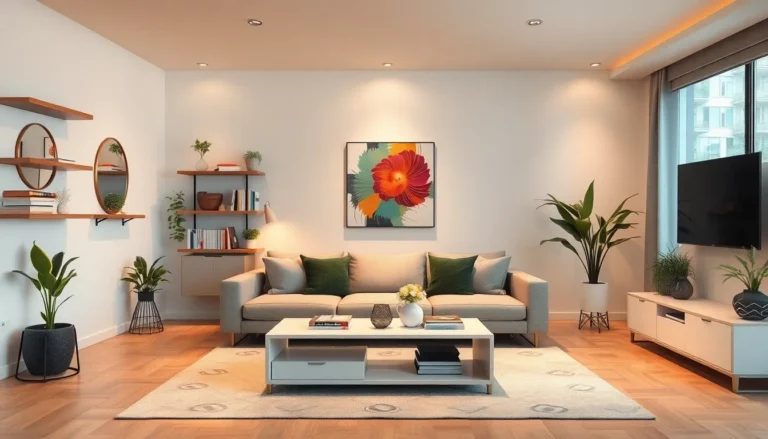Imagine walking into an office that feels more like a cozy coffee shop than a place of work. That’s the magic of commercial interior design firms. They transform mundane spaces into vibrant environments that inspire creativity and productivity. Whether it’s a sleek corporate headquarters or a trendy retail store, these design wizards know how to sprinkle a little pixie dust on every square foot.
But it’s not just about aesthetics. A well-designed space can boost employee morale and impress clients, making it a smart investment for any business. So why settle for bland when you can have bold? Dive into the world of commercial interior design and discover how these firms turn the ordinary into the extraordinary, one stylish office at a time.
Table of Contents
ToggleOverview of Commercial Interior Design Firms
Commercial interior design firms specialize in creating functional and aesthetically pleasing environments for various business types. These firms work with clients to develop spaces that meet specific branding and operational needs, ultimately enhancing user experiences. Many of these firms offer services such as space planning, furniture selection, and lighting design.
Design professionals understand that the right environment can boost productivity and foster collaboration. They consider aspects like color schemes, layout, and materials, ensuring every element aligns with the client’s vision. Trends in commercial interior design include biophilic design, flexible workspaces, and technology integration, influencing how spaces are structured.
Collaboration plays a vital role in the design process. Interior designers often partner with architects and contractors to execute their concepts accurately. By involving multiple disciplines, firms ensure that design elements are cohesive and functional. Client feedback remains crucial, as ongoing communication allows designers to refine ideas until the final product resonates with the intended purpose.
Market demands shape the approach of these firms. For instance, sustainable practices are increasingly prioritized, focusing on eco-friendly materials and energy-efficient solutions. This commitment to sustainability not only appeals to environmentally conscious clients but also meets regulatory requirements.
Commercial interior design firms aim to create impactful spaces that reflect a company’s identity. Through thoughtful planning and innovation, these designs facilitate not just visual appeal but also operational efficiency. Ultimately, the work of these firms influences how businesses present themselves to clients and how employees engage with their work environment.
Key Services Offered
Commercial interior design firms provide a variety of specialized services that enhance business environments. These services focus on creating functional and appealing spaces tailored to specific needs.
Space Planning and Layout
Space planning and layout are critical for maximizing efficiency and functionality. Designers assess the flow of movement within a space, ensuring that each area serves its purpose effectively. They utilize 2D and 3D designs to visualize layouts, allowing clients to understand spatial relationships clearly. By considering factors such as traffic patterns, employee interactions, and zoning, designers create workspaces that promote collaboration and productivity. Ergonomic considerations rank high, ensuring comfort and safety are part of every plan.
Furniture and Finish Selections
Furniture and finish selections significantly influence a workspace’s aesthetic and functional value. Designers source furniture that complements both the company’s brand and operational needs. They focus on durability, comfort, and style, evaluating materials and finishes that align with environmental sustainability goals. Color selections impact mood and productivity, so designers thoughtfully choose palettes that resonate with company culture. Custom solutions often arise from unique requirements, ensuring that each element reflects the company’s identity while meeting practical demands.
The Importance of Collaboration
Collaboration plays a vital role in the success of commercial interior design. Effective teamwork enhances project outcomes, ensuring that client expectations align with design innovations.
Working with Clients
Understanding client needs remains essential for interior designers. They engage clients through consultations, identifying unique preferences and requirements. Gathering feedback throughout the design process establishes a strong partnership. Designers translate ideas into visual concepts, demonstrating how designs support business goals. Reviews of design iterations foster transparency, leading to successful implementations. Ultimately, effective communication drives satisfaction and cultivates lasting relationships.
Partnering with Contractors
Collaboration with contractors streamlines project execution. Designers work closely with contractors to ensure that design intent translates into reality. Regular meetings clarify timelines, budgets, and construction details. Designers provide specifications that guide contractors, reducing miscommunication. Swift problem-solving arises from a responsive partnership, facilitating seamless integration of design elements. Trust among parties contributes to successful projects, enhancing quality and efficiency. Together, designers and contractors create environments that resonate with clients’ visions.
Trends in Commercial Interior Design
Current trends in commercial interior design emphasize innovation and sustainability. Firms adapt to evolving workplace needs while focusing on functionality and aesthetics.
Sustainable Design Practices
Sustainable design practices have gained significant traction in commercial spaces. Designers prioritize eco-friendly materials that minimize environmental impact. Many firms implement energy-efficient solutions, such as LED lighting and high-performance HVAC systems. Materials like reclaimed wood and recycled metal often appear in projects, enhancing both style and sustainability. The shift towards greener practices reflects a growing market demand, as businesses increasingly aim to reduce their carbon footprints. Investing in these sustainable solutions not only benefits the planet but also boosts the company’s image.
Innovative Technology Integration
Innovative technology integration shapes modern commercial spaces. Designers incorporate smart systems for lighting, climate control, and security, enhancing user experiences. Automation tools streamline workflows and improve efficiency, allowing for seamless collaboration. Some firms utilize augmented reality and virtual reality to present designs, providing clients with immersive previews. Wireless charging stations and high-speed connectivity support the needs of today’s workforce. As technology continues to evolve, its role in interior design becomes increasingly critical, supporting both form and function in the workplace.
Choosing the Right Firm
Choosing a commercial interior design firm involves several critical factors. Start by assessing the firm’s portfolio to ensure alignment with your vision. Look for previous projects that resonate with your brand identity and values. Verifying client testimonials adds another layer of confidence in their capabilities.
Consider the firm’s expertise in relevant services, including space planning and furniture selection. Evaluate their approach to latest trends like biophilic design and technology integration, as these elements enhance functionality and appeal. Gathering information about their sustainable practices also highlights their commitment to eco-friendly solutions, which is increasingly important in today’s market.
Communication plays a vital role in the selection process. Ensure the firm prioritizes collaboration and responds promptly to inquiries. A strong partnership often leads to mutual understanding, significantly impacting the success of the project. Take into account their willingness to adapt to your specific branding and operational needs, which is crucial for a cohesive final result.
Budgeting creates another important consideration. Request comprehensive proposals that clearly outline costs and timelines. Budget transparency enables informed decision-making and helps avoid unforeseen expenses. Understanding how the firm manages resources can also reveal their operational efficiency.
Look for a firm that embraces innovative technology. Integrating smart systems can streamline workflows while enhancing overall user experience. Considering the rapidly evolving landscape of commercial interiors, firms that keep pace with advancements demonstrate their capacity to meet future demands.
Ultimately, the right firm should not only meet design needs but also reflect your company’s identity and vision, enhancing both employee morale and client impressions.
Investing in a commercial interior design firm can significantly elevate a business’s environment. By transforming ordinary spaces into inspiring workplaces, these firms not only enhance aesthetics but also boost employee morale and productivity.
As trends shift toward sustainability and technology integration, choosing the right design partner becomes crucial. A firm that prioritizes eco-friendly practices and innovative solutions can create spaces that resonate with a company’s values.
Ultimately, the right commercial interior design firm will help businesses reflect their identity while fostering collaboration and efficiency. This investment pays off in improved client interactions and a thriving workplace culture.








